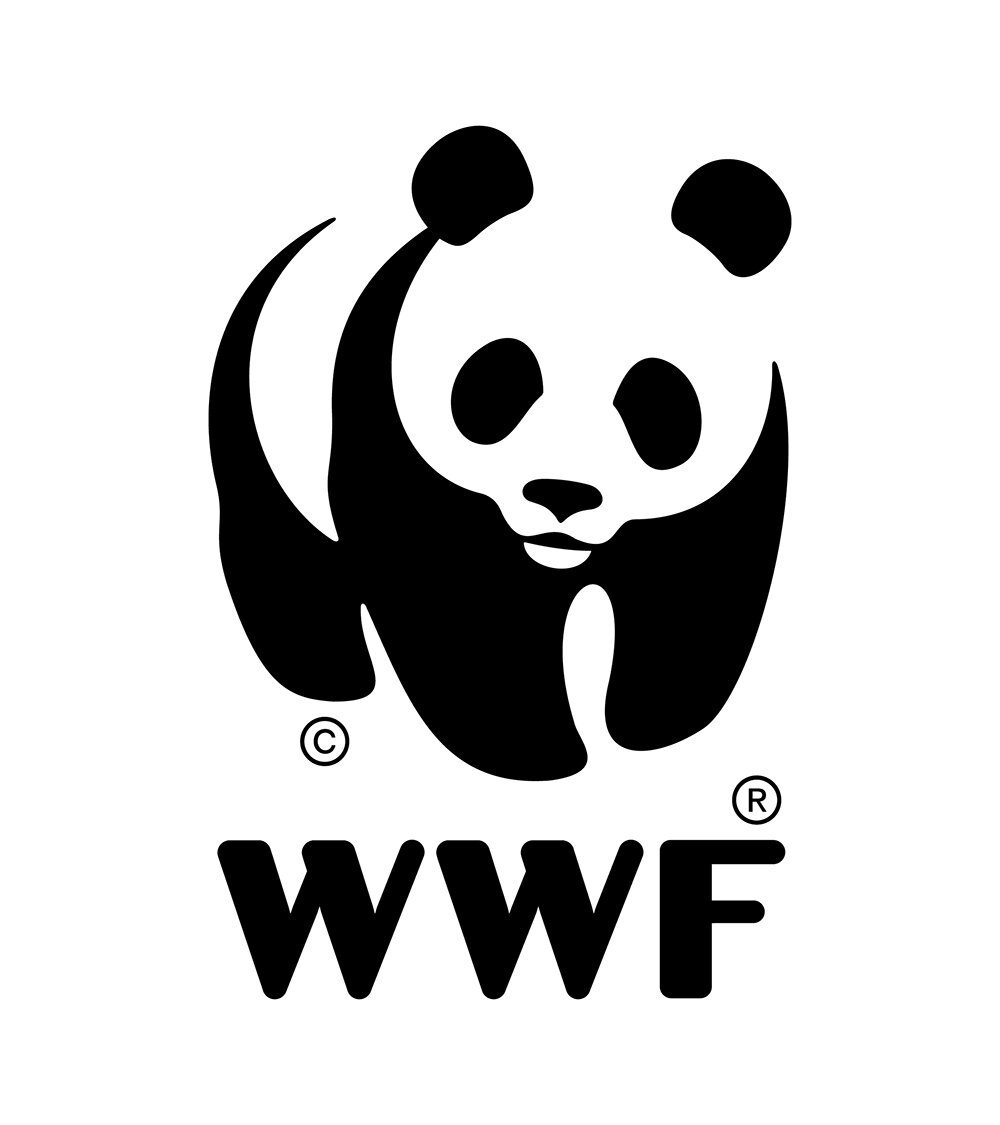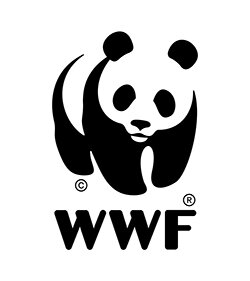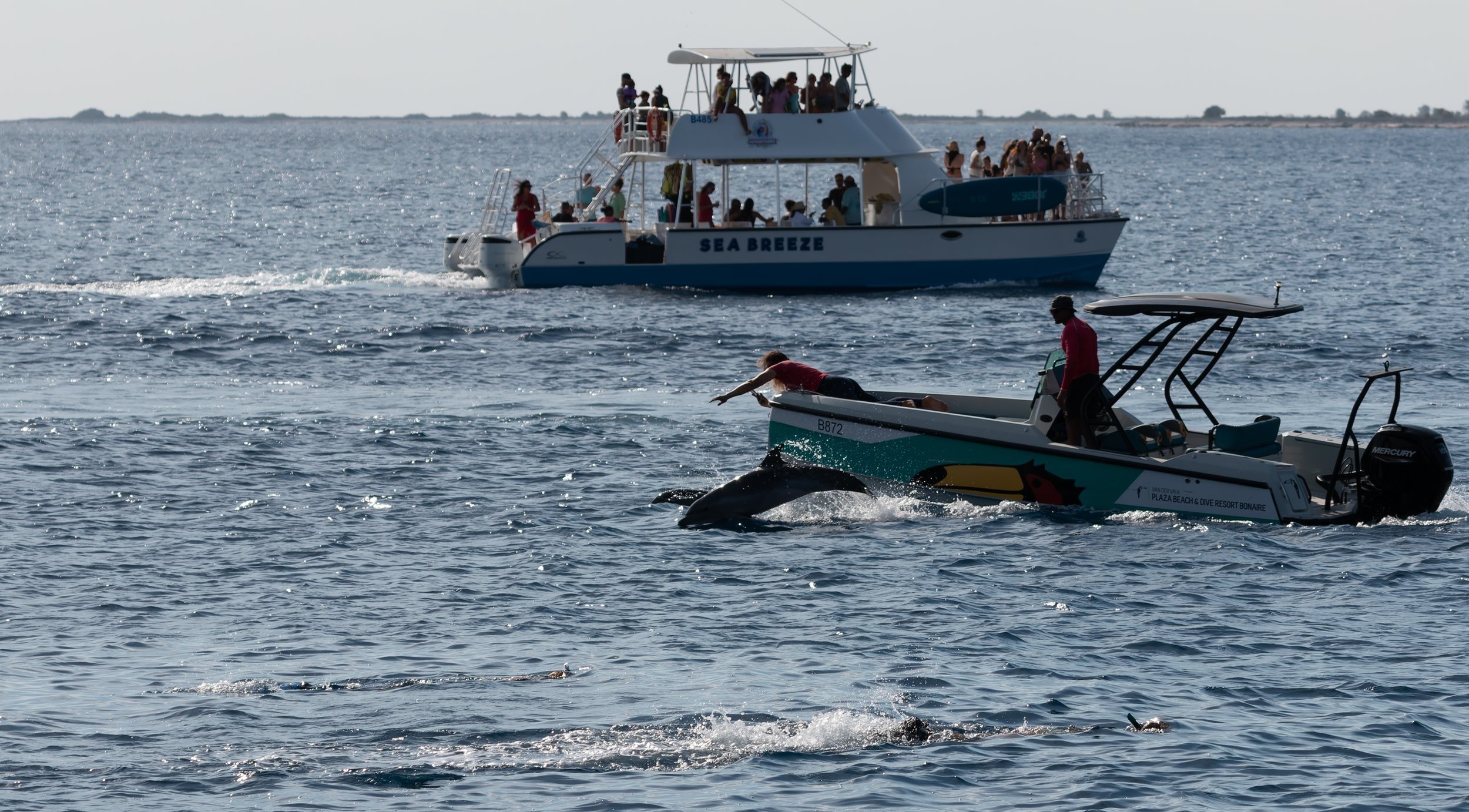A Connected Caribbean – Dolphins on the move in a sea under pressure
14 April 2025
Spinner dolphins spotted near Aruba, Dutch Caribbean, during one of the monitoring expeditions by the Caribbean Cetacean Society in 2024 © CCS
In the crystal-blue waters of the Caribbean, something remarkable surfaced. When Stacey Mac Donald, a researcher and a Regional Coordinator at the Caribbean Cetacean Society (CCS), received confirmation of a photo-identification match of a spinner dolphin mother and calf first sighted in Martinique in 2021 and then again in Bonaire in 2024—more than 800 kilometers away—the team had a genuine “wow” moment.
“We’ve got a match!”
“For the first time in our work we’ve confirmed a photo-ID match between Martinique and the ABC Islands [Aruba, Bonaire, and Curaçao],” said Stacey. “It means we photographed the same animal in two locations—three years apart. That’s a significant discovery, especially when we still know so little about where these dolphins feed, rest, and travel. This finding is truly groundbreaking for our team.”
Stacey and her team suspect that the rest of the pod travelled with the spinner dolphin mum and her calf between the islands but as the data is still being analysed, we don’t know this for certain just yet.
This new evidence offers important insight into the movement and range of spinner dolphins—a relatively small, oceanic species found throughout the region. It also reinforces a timely and urgent message: dolphins are a shared Caribbean treasure, moving freely across national borders, but in a sea that is transforming under growing pressures.
A Google Earth map showing the distance between Martinique and Bonaire © Google; Data SIO, NOAA, U.S. Navy, NGA, GEBCO; Landsat / Copernicus
A screenshot from Flukebook showing the spinner dolphin photo ID matches between Martinique and Bonaire. CCS intern, Ioena Le Guillou, currently writing her Master’s thesis on spinner dolphins in the Caribbean using CCS-collected data, identified the match during her analysis. © CCS / Flukebook
The Caribbean Sea - a marine biodiversity hotspot under pressure
Home to more than 33 species of marine mammals—over a third of the world’s whales, dolphins, and porpoises—the Caribbean is a vibrant crossroads of marine life. The region is home to at least 16 species from the Delphinidae family, ranging from spinner dolphins as the smallest to orcas as the biggest. As Stacey revealed, the dolphin pods they tend to encounter on their trips are on average 100-individuals-strong. Sadly, this diverse ecosystem faces growing threats.
Tobacco Cays, Saint Vincent and the Grenadines © CCS
Heavy ship traffic—from container ships to cruise liners and recreational boats—brings the risk of vessel strikes and adds significant underwater noise pollution, which can disrupt dolphin communication, socialisation, and resting. Fishing activities, including the use of gillnets and longlines, pose a serious risk of entanglement and accidental bycatch. Dolphins are also directly targeted on some islands too, where they’re caught for local consumption. Climate change is accelerating coral reef loss, warming waters, and altering food webs. Together, these cumulative impacts create a dangerous obstacle course for dolphin pods to navigate as they raise their young.
Harassment of dolphins observed in Bonaire, 2024 © Gwen Versteegh / CCS
Tracking dolphins over time using new tech
Tracking a dolphin across thousands of kilometers isn’t easy. These highly mobile, fast-moving animals spend much of their lives beneath the waves. But scientists are unlocking their mysteries with tools like photo-identification, using images of dorsal fins or tail flukes—each uniquely marked with scars or notches, similar to a human fingerprint—to recognize individuals over time.
Thanks to web-based platforms like Flukebook—dubbed “Facebook for whales and dolphins”—the process is having real impact. This AI-powered tool compares photos from researchers and citizen scientists from around the world, rapidly identifying matches that used to take hours or days of manual analysis.
“Flukebook uses a machine learning algorithm to match photographs of dolphins across years and countries,” explained Stacey. “In just a few minutes, we can uncover movement patterns that would have previously taken weeks to months of effort.”
Still, meaningful discoveries take time. The Martinique–Bonaire match took three years to confirm. “That’s the nature of dolphin science,” said Stacey. “Every confirmed sighting is a puzzle piece—and each one brings us closer to understanding how these animals use the Caribbean Sea.”
“Ti Whale An Nou” – building local knowledge
Stacey Mac Donald during one of the ‘Ti Whale An Nou’ expeditions © CCS
To deepen regional understanding, CCS launched Ti Whale An Nou (“Our Own Little Whales” in a mix of Creole, English, and French) in 2021—a pioneering research and outreach programme focused on whales and dolphins across the Caribbean.
Each year, CCS teams conduct surveys across the Caribbean, training local biologists and inviting ‘citizen scientists’ to join expeditions to fill an important knowledge gap about these species. In just three years, the programme has trained over 300 people across 20 territories and studied hundreds of cetacean groups.
Importantly, these surveys are helping to map critical habitats—feeding grounds, nurseries, and migration routes—essential for long-term conservation planning.
“We’ve seen that our expeditions really help ignite a spark,” Stacey said. “Participants often continue their efforts long after the expeditions end.”
One example is Gwen Versteegh, a local resident turned citizen scientist from Bonaire, who now leads year-round dolphin monitoring efforts on the island. Over the past two years, Gwen has documented the presence of spinner, rough-toothed, and bottlenose dolphins around Bonaire.
While further research is needed, early findings suggest that the same pods may be returning to the island regularly. We now know that some dolphins venture as far as Martinique after leaving Bonaire, but how they get there and which route they follow remains a mystery.
Why dolphins matter - and what we can do
A common bottlenose dolphin (Tursiops truncatus) is using a technique of crater-feeding in Bimini, Bahamas. Two calves are watching the adult to see if she can catch food. © Judith van de Griendt / WWF. This work was performed under authorization 02/ORAC/24/judithvandegriendt.
Dolphins aren’t just iconic marine mammals—they’re important indicators of ocean health. As top predators, they keep ecosystems in balance. Their presence indicates a healthy marine food web. They also help fertilise their habitats by spreading nutrients when they poop, just like their large cousins - whales - have long been known to do. When dolphins move out of a region or a local population declines, it signals broader problems that can affect biodiversity, food security, and even local economies.
Protecting dolphins means protecting the ocean—and by extension, the people who rely on it.
That’s why WWF is partnering with groups such as CCS and others working together to contribute to IUCN Important Marine Mammal Areas (just like the 43 recently announced IMMAs in the region), expand Marine Protected Areas (MPAs), and promote international frameworks like the UN High Seas Treaty (Agreement on the Biodiversity Beyond National Jurisdictions). These tools help safeguard important ocean areas for dolphins (as well as other cetaceans) that don’t recognise political borders.
“Dolphins don’t carry passports,” Stacey reminds us. “They move freely across jurisdictions - including those where they and their habitats are protected, and those with no protections at all. That’s why collaboration across islands and countries is absolutely essential.”
Blue Corridors - A vision for a connected future
The ultimate goal? To collaboratively protect the full migratory range of marine mammals like spinner dolphins—through well-managed, connected areas known as blue corridors. These routes link vital habitats, allowing dolphins to move safely across their range while keeping communities at the heart of conservation.
Turning this vision into reality will require cooperation—between local communities, researchers, conservation organisations and governments. Because when we protect dolphins, we’re not just conserving an iconic species—we’re investing in a thriving ocean for all.








